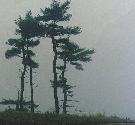This same uncomplicated and reverent regard for the beauty of God's created world is reflected in the way Trappist monks approach death.
This is why the monastery is a kind of prophetic place, an anticipation of the world to come, a permanent declaration of a universe re-made in God, a universe whose poles are charity and the praise of God. (Andre Louf, The Cistercian Way, p. 60.)
For Trappists, there is beauty in death because it is treated as a natural part of life. That is why Trappists do not try to hide what happens to the body at death or interfere with the natural process of returning it to the earth.
The reason Trappists are able to see death in this light is because they believe something much greater is taking place. It is the final step along a path they have been following all along—the path to God.
 I do not know, except by Christian faith, what lies beyond this life. In death I lose everything without knowing for sure that there is anything to follow. Faith, however, assures me that there is a God who is like a loving father or mother. The ultimate reality is not death and extinction. But God. (Charles Cummings, Monastic Practice, p. 192.)
I do not know, except by Christian faith, what lies beyond this life. In death I lose everything without knowing for sure that there is anything to follow. Faith, however, assures me that there is a God who is like a loving father or mother. The ultimate reality is not death and extinction. But God. (Charles Cummings, Monastic Practice, p. 192.)






